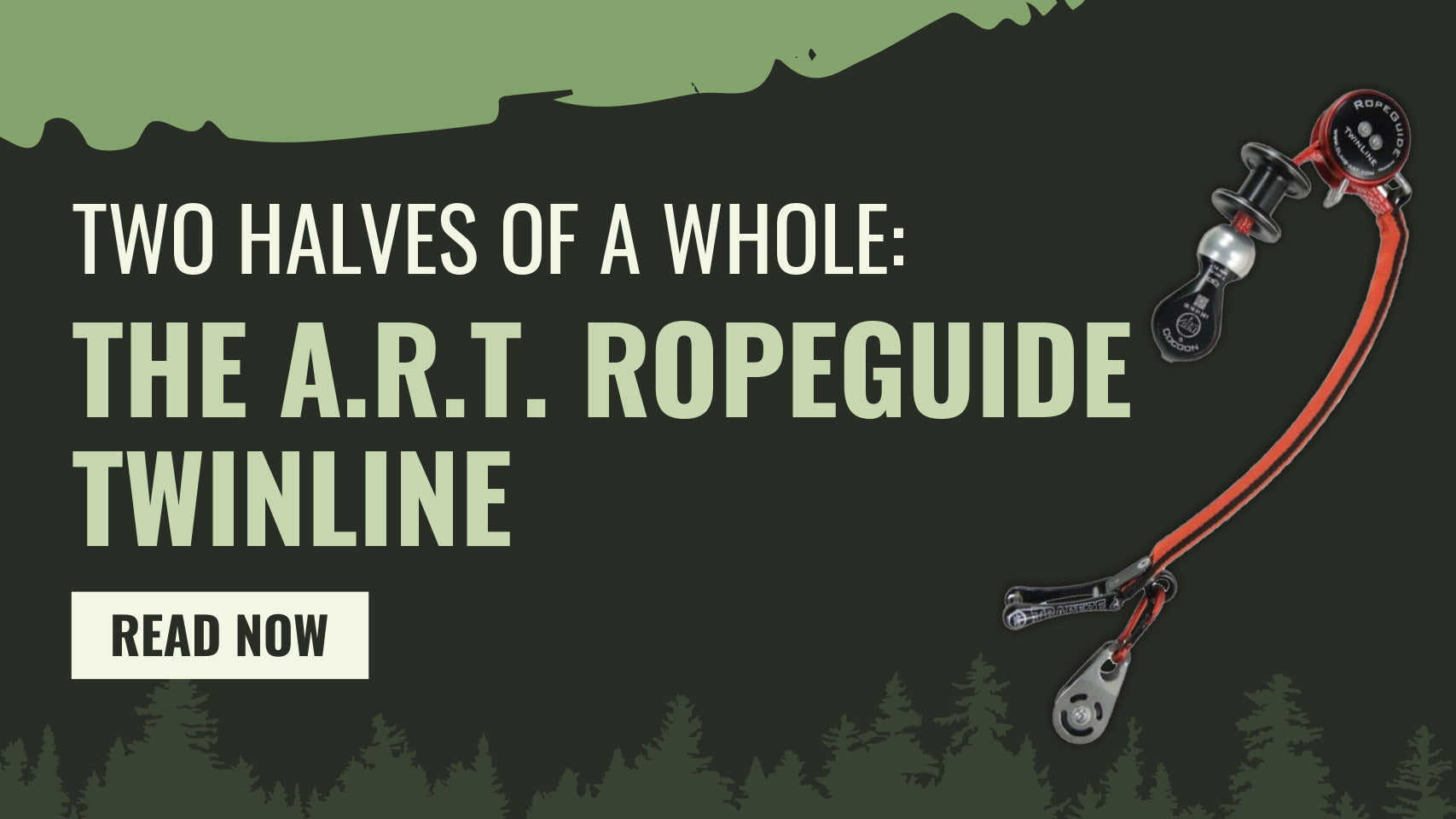
The A.R.T. Rope Guide Twinline Friction Saver: The Pinnacle of Friction Saver Innovation
Advanced Ropeclimbing Technology (A.R.T.) introduced the A.R.T. RopeGuide Twinline friction saver around 2016-2017 to the tree care market; a device that meets the demands for safety, efficiency, and adaptability in tree climbing. This innovative friction saver is designed to enhance both Stationary Rope System (SRS, formerly SRT) and Moving Rope Systems. The Twinline is a robust, smooth, and intelligent solution that has quickly become a preferred tool among arborists worldwide.

What Sets the RopeGuide Twinline Apart?
This specific friction saver is not merely an enhancement from previous ring-style friction savers; it represents a significant advancement in multifunctionality and user-centric design. Unlike other friction savers available that only accommodate one rope at a time, A.R.T. has engineered the RopeGuide Twinline to support two independent ropes simultaneously – both M.R.S. and S.R.S/S.R.T. Switching seamlessly is a huge flex with this canopy (crown) anchor, allowing the climbing arborist to ascend AND work while in S.R.S, and easily transfer to the M.R.S. system when the arborist is ready. This versatility improves the workflow and reduces the need to install additional hardware aloft.
Component Breakdown
-
Cocoon 5 Pulley – Equipped with 2 encapsuled, high-quality ball bearings, so get ready for the smoothest ride of your entire climbing career!
-
ZipAbsorber – In the event of the climber not having a taut climb line and a slip occurs, the ZipAbsorber assists with shock absorption from a vertical fall.
-
Cam Adjuster – Friction clutch
-
Slider Spool – Made of high-tensile plastic, this Slider Spool is designed to work with the stationary anchoring rope and secures the system in place.
-
Trapeze 5 & Retrieval Ball– Retrieval ball catches onto the Trapeze and lowers the friction saver to the ground.
-
Additional components that can pair successfully with this friction saver: StopperGate and a Splice Anchor.
Most A.R.T. products have components designed to be replaceable.
Installation
In the initial learning phase, the anchoring system proved to consume time, but like any task that necessitates improvement, repetition is essential for proficiency. And with that, the following tools are required for setup:
-
RopeGuide Twinline friction saver
-
Primary climbing rope
-
Secondary (ascent/rescue) climbing rope
-
A.R.T. Splice Anchor (optional)
-
A.R.T. StopperGate (optional)
If you plan to install from the ground, isolating them with your throwline will be necessary; patience is required!
-
Once isolated around the desired and suitable section of tree, install the secondary tree climbing rope through the friction cam of the Twinline.
-
Attach the Twinline via Trapeze or XSRE carabiner to the gear bag and follow by pulling the secondary rope up through the branch union.
-
Attach the working end to the Slider Spool with a Girth Hitch and further secure it by adding a stopper knot.
-
This is a crucial step in the setup procedure.
-
Install the primary tree climbing rope through the Trapeze and then through the Cocoon pulley.
-
Secure the eye splice of the primary rope to the gear bag, ensuring the rope stays at ground level while the system is pulled aloft.
-
Configure the moving rope system and have it trail the user while ascending on the access line, or:
-
Configure a preferred moving rope system and tie an Alpine Butterfly onto the spliced eye side (2-3 feet from the splice), and this will jam into the Cocoon pulley, allowing the user to ascend SRS/SRT on the primary climbing rope and keeping the access line free for a separate climber. The moving rope system will need to be spiked to prevent it from traveling higher and into the Cocoon.
-
Once the user reaches the Twinline, they must secure themselves prior to reconfiguration.
-
This ascent method is for access only.
The optional splice anchor and StopperGate can be used as described below:
-
If the user prefers a more traditional style friction saver, A.R.T.’s Splice Anchor can be used. Installation cannot be done from the ground; it must be done while aloft. At times, this method is used to install friction savers by shooting slightly under and advancing to the final tie-in point, to perform a thorough inspection of the anchor point on questionable trees.
-
The StopperGate allows the achievement of a working canopy anchor from the Cocoon pulley. The initial setup remains the same, however, the StopperGate must be attached to the Trapeze, and an Alpine Butterfly secured on the underside of the StopperGate. This can all be staged on the ground, with the only challenge being determining how much rope is required to reach the ground for retrieval.
Psst…
-
This anchoring system is perfect for those who practice or wish to get better at leaving an access line ready in the event of an emergency
-
Not only can this secondary rope be left as an access line, but a second climber can work on this leg of rope while there is another on the primary climbing rope, so long as the tie-in point can withstand the load.
-
With the previous statement, this system is rated for a two-person load (550 lbs.), great for rescue in the event of a climber having compromised gear, with the correct anchor point.
-
Last but not least, when a cinch style anchor is needed, the Twinline works wonders with either their Splice Anchor or a secondary climbing rope!
Final Thoughts
Advanced Ropeclimbing Technology (A.R.T.) is renowned for designing some of the industry's finest equipment and continues to lead in innovation. One of their premier products is the RopeGuide Twinline, among many others that exemplify their commitment to quality and performance. Furthermore, A.R.T. has recently introduced their latest climbing device, the BlackBird. If you have experience with the Twinline or currently utilize it, we invite you to share your feedback.




Leave a comment